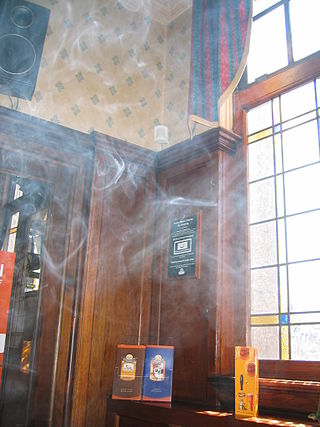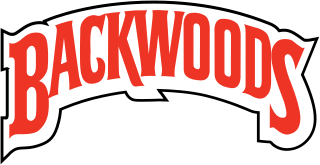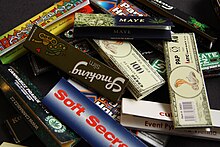
A roll-your-own (RYO) cigarette, also called a handrolled cigarette, is a cigarette made from loose tobacco and rolling paper. Factory-made cigarettes are called industrial cigarettes.

A cigar is a tobacco product made to be smoked. Cigars are produced in a variety of shapes and sizes. Since the 20th century, almost all cigars are made of three distinct components: the filler, the binder leaf which holds the filler together, and a wrapper leaf, for appearance and flavor, which is often the highest quality leaf used. Often there will be a cigar band printed with the cigar manufacturer's logo. Modern cigars can come with two or more, highlighting special qualities such as age and origin of the tobaccos used.

A cigarette is a narrow cylinder containing a combustible material, typically tobacco, that is rolled into thin paper for smoking. The cigarette is ignited at one end, causing it to smolder; the resulting smoke is orally inhaled via the opposite end. Cigarette smoking is the most common method of tobacco consumption. The term cigarette, as commonly used, refers to a tobacco cigarette, but the word is sometimes used to refer to other substances, such as a cannabis cigarette or an herbal cigarette. A cigarette is distinguished from a cigar by its usually smaller size, use of processed leaf, and paper wrapping, which is typically white. Most modern cigarettes are filtered, although this does not make the smoke inhaled from them contain fewer carcinogens and harmful chemicals.

Tobacco smoke is a sooty aerosol produced by the incomplete combustion of tobacco during the smoking of cigarettes and other tobacco products. Temperatures in burning cigarettes range from about 400 °C between puffs to about 900 °C during a puff. During the burning of the cigarette tobacco, thousands of chemical substances are generated by combustion, distillation, pyrolysis and pyrosynthesis. Tobacco smoke is used as a fumigant and inhalant.

Tobacco smoking is the practice of burning tobacco and ingesting the resulting smoke. The smoke may be inhaled, as is done with cigarettes, or simply released from the mouth, as is generally done with pipes and cigars. The practice is believed to have begun as early as 5000–3000 BC in Mesoamerica and South America. Tobacco was introduced to Eurasia in the late 17th century by European colonists, where it followed common trade routes. The practice encountered criticism from its first import into the Western world onwards but embedded itself in certain strata of a number of societies before becoming widespread upon the introduction of automated cigarette-rolling apparatus.

A blunt is a cigar which is wider than a cigarillo and not quite as wide as a Corona, generally equivalent to a petit corona while short panatellas are sometimes classified as mini-blunts. These cigars typically consist of two main parts; the inner leaf, which is similar to a cigarette rolling paper, except it is made of tobacco, and a thicker outer leaf which is rolled around the inner leaf in a spiral. In most commercially available blunts, the "leaves" are not actual tobacco leaves but rather paper made from tobacco pulp.

Davidoff is a Swiss premium brand of cigars, cigarettes and smoker's accessories. The Davidoff cigarette brand has been owned by Imperial Brands after purchasing it in 2006. The non-cigarette portion of the Davidoff tobacco brand is owned by Oettinger Davidoff AG, which is based in Basel, Switzerland.

A cigarillo is a short, narrow cigar. Unlike cigarettes, cigarillos are wrapped in tobacco leaves or brown, tobacco-based paper. Cigarillos are smaller than regular cigars but usually larger than cigarettes. Cigarillos are usually made without filters, and are meant to be smoked like a cigar and not inhaled.

Dutch Masters is an American brand of natural wrapped cigars that has been sold since 1912. Its distinctive packaging features Rembrandt's 1662 painting Syndics of the Drapers' Guild. Dutch Masters cigars are currently manufactured and sold by Imperial Brands. They are machine-rolled cigars and come in two varieties: standard cigars and smaller cigarillos. Dutch Masters are a common choice for cannabis smokers who like to roll blunts.

Kretek are unfiltered cigarettes of Indonesian origin, made with a blend of tobacco, cloves, and other flavors. The word "kretek" itself is an onomatopoetic term for the crackling sound of burning cloves.

A beedi is a thin cigarette or mini-cigar filled with tobacco flake and commonly wrapped in a tendu or Piliostigma racemosum leaf tied with a string or adhesive at one end. It originates from the Indian subcontinent. The name is derived from the Marwari word beeda—a mixture of betel nuts, herbs, and spices wrapped in a leaf. It is a traditional method of tobacco use throughout South Asia and parts of the Middle East, where beedies are popular and inexpensive. In India, beedi consumption outpaces conventional cigarettes, accounting for 48% of all Indian tobacco consumption in 2008.

Shag, also known as rolling tobacco or loose tobacco, is fine-cut tobacco, used to make self-made cigarettes by hand rolling the tobacco into rolling paper or injecting it into filter tubes. It got its name from the finely cut strands appearing like 'shag' fabric and was originally considered poor quality. Various types of cut are used; most shag blends use a simple mixture of cutting styles, consisting mostly of loose cut but also krumble kake, ribbon cut and flake may be used. Some shag blends use cuts reminiscent of pipe tobacco. These were imported to the United Kingdom by Rory Innes following the Virginia tobacco plantations in North America.

A cigarette filter, also known as a filter tip, is a component of a cigarette, along with cigarette paper, capsules and adhesives. Filters were introduced in the early 1950s.

Backwoods is an American brand of cigars that was introduced in 1973. This product was notable during the 1970s and 1980s for heavy advertising, which became one of the more obvious examples of how companies at the time reacted to changing laws and cultural views on public health and smoking culture.

Flavored tobacco products — tobacco products with added flavorings — include types of cigarettes, cigarillos and cigars, hookahs and hookah tobacco, various types of smokeless tobacco, and more recently electronic cigarettes. Flavored tobacco products are especially popular with youth and have therefore become targets of regulation in several countries.
Laredo was a tobacco kit introduced by Brown & Williamson in the early 1970s. It was sold with the slogan, "If you want something done right, do it yourself". The kit consisted of a tin of tobacco, a plastic cigarette-making device, and loose cigarette papers and filters. The Laredo brand tobacco and a filter were inserted into the device, and then a lever was pulled to compress the tobacco. Another lever slid the plug of tobacco and the filter into an empty cigarette paper tube to form a homemade cigarette.

A joint is a rolled cannabis cigarette. Unlike commercial tobacco cigarettes, the user ordinarily hand-rolls joints with rolling papers, though in some cases they are machine-rolled. Rolling papers are the most common rolling medium in industrialized countries; however, brown paper, cigarettes or beedies with the tobacco removed, receipts and paper napkin can also be used, particularly in developing countries. Modern papers are manufactured in a range of sizes from a wide variety of materials including rice, hemp, and flax, and are also available in liquorice and other flavoured varieties.

In the United States, cigarettes are taxed at both the federal and state levels, in addition to any state and local sales taxes and local cigarette-specific taxes. Cigarette taxation has appeared throughout American history and is still a contested issue today.

A blunt is a cigar that has been hollowed out and filled with cannabis. It is rolled with the tobacco-leaf "wrap", usually from an inexpensive cigar, or any other wrap that is not a joint paper that has glue. A blunt is different from a joint, which uses rolling papers.






















